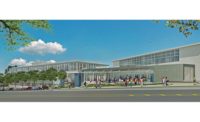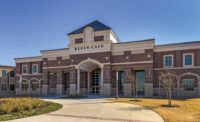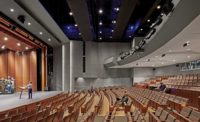When officials with Kenner Discovery Health Sciences Academy set out to build a $31-million high school, they envisioned having the senior class graduate from the building this spring.
For the team building the 125,000-sq-ft project in the New Orleans suburb of Kenner, meeting that objective would mean working against a tight deadline to construct the first built-from-the-ground-up public school on the east bank of Jefferson Parish since the 1980s. The team relied on precast construction, a design-assist approach and meticulous planning to meet the demanding schedule—all while building a heavy concrete structure atop unforgiving, mucky soil.
“Additionally, there were economic drivers that compressed the owner’s timeline. Therefore, during preconstruction, speed to completion was a focus for the team,” says Nicholas Moldaner, project executive for lead contractor Palmisano.
The Kenner Discovery project began in November 2018 and is scheduled for completion by late February, in time for seniors to move in by the end of March. The school was founded in 2013 with a limited number of grade levels and has added new grade levels and students every year since. The class of 2020 is Kenner Discovery’s first senior class.
The high school project is the first of a three-phase, decade-long plan to create an entirely new campus for pre-K through 12th grade. The second and third phases will consist of wings for middle and elementary schools.
On-Time Attendance
The construction team was able to reduce the overall project timeline by at least six months, including three months of preconstruction and three months of construction.
The contractor came in early on the project and worked with Sizeler Thompson Brown Architects in a design-assist capacity to complete construction documents. Through this approach, the project team was able to accelerate the seven-month preconstruction and 15-month construction schedules.
“With a head start on design discussions during initial programming meetings with the school’s stakeholders, the initial design concept and layout came together rather quickly. Experience with similar school programs and local site constraints helped,” says Brian Faucheux, principal with Sizeler Thompson Brown, which previously designed four post-Katrina public schools in the city of New Orleans.
Weekly meetings between the design team, contractor, owner and major subcontractors facilitated cost savings by ensuring coordination and identifying construction issues as the design was finalized.
“The preconstruction collaborative planning process went well and ultimately saved time, money and reduced change orders in the field,” Faucheux says, adding that the team kept costs near level and total change orders at less than three-quarters of 1%.
Precast Efficiencies
The use of precast concrete is a growing trend in K-12 school construction because it offers cost and time savings as well as sustainability benefits.
The contractor led an effort to evaluate the use of precast for the project’s structure in lieu of a more conventional stick-built, steel structure. “Ultimately, the erection speed and long-term resiliency of an all-concrete building drove the team to move forward with precast concrete as the building’s main structure,” Moldaner says.
Compared with a traditional onsite erection process, the precast concrete approach helped accelerate work by more than six weeks, reducing the project duration by more than 10%.
Crews erected 113,000 sq ft of precast structure in 68 days. This included 539 precast concrete units—including walls, beams, columns and double-tees—in just over 11 weeks.
“Because the project had such a short schedule, the precast shop drawings had to be developed before the construction documents were issued by the design team.”
– Stephannie Williams, Structural Engineer, Schrenk Endom & Flanagan
Most of the mechanical and plumbing systems were also prefabricated. The HVAC ductwork and system components were built into a series of racks in a controlled environment a few miles from the project, and then were installed on site. “This prefab process resulted in higher quality work and faster install durations, effectively taking HVAC off the critical path of the project schedule,” Moldaner says.
The one exception in the new precast design was the school library, which features a lighter steel structure and a colorful exterior metal-panel skin to stand out as a special element among the all-concrete building.
The architect used varied textures and colors in the precast—including etched, sandblasted and ribbed form-liner—to add interest and contrast to the flat-paneled exterior.
“These combinations of exterior precast and metal panel, texture and color, aluminum and glass were important to bring the building to life—to reflect the vibrancy of the Discovery community spirit that it will house,” Faucheux says.
Using precast concrete for a school building, as opposed to a simpler structure like a parking garage, required significant collaboration with the precast engineer to accommodate architectural details and finishes, according to the project’s structural engineer, Schrenk Endom & Flanagan LLC. The company worked closely with the contractor and the precast supplier, Tindall Corp., during the design phase to help save time and money.
“Because the project had such a short schedule, the precast shop drawings had to be developed before the construction documents were issued by the design team,” says Stephannie Williams, structural engineer for Schrenk Endom & Flanagan.
Sections of the building constructed from structural steel would need to connect directly to the precast concrete.
“This means we had to focus on early coordination between the steel and concrete portions of the building to make sure all the pieces came together during construction,” Williams says. All told, the structure included 4,500 cu yd of concrete and 163 tons of steel.
Mucking About
Although precast concrete offered several benefits, the use of this option for such a large project—atop marshy south Louisiana soils—required extensive planning and careful execution.
Subsidence is a major challenge in the New Orleans area, so supporting the weight of the foundation and the concrete structure that would go on top of it was critical to the project’s structural design. “We put a heavy concrete building on very poor soils,” Williams says.
Kenner’s clay-like soils are among the most challenging in the region to build on. Because Kenner was swampland until its development in the late 1950s, the soils are boggy and highly unfavorable for construction. The soil has even received its own classification, “Kenner muck,” in state and federal soil surveys.
Because of these conditions, the project team needed to give special consideration to supporting the structure and anticipating any settlement that would occur between it and the surrounding area.
The team used roughly 1,200 70-ft-long composite timber piles to support the structure. “The use of composite piles is not unique in this region, but they are not commonly used in other parts of the country,” Williams says.
Sustainability Goals
The project team designed the school layout with the input of school CEO Patty Glaser. Technology was essential to her vision for the new campus as well interior spaces conducive to collaboration and interaction. “We’re one of the largest schools in Jefferson Parish, if not the largest school,” Glaser says. “So my goal was to create long-term sustainability.”
The new campus will need to accommodate Kenner Discovery’s continued exponential growth. When the school first opened in 2013, it served 420 students in select grade levels. Today, it serves 1,850 students in grades pre-K through 12 and has more than 200 teachers. Also this spring, Kenner Discovery is opening a second elementary school campus on Jefferson Highway in partnership with Ochsner Health System, which means there will be two lower-grade schools feeding into the middle and high school.
The high school will feature a three-story academic wing with 53 classrooms and 11,495 sq ft of administrative facilities, an outdoor plaza, a teaching kitchen and paved concrete parking for 316 vehicles.
Because Kenner Discovery specializes in health sciences, the new building includes nine science labs, including a hospital simulation room with three beds as well as traditional biology, chemistry and physics labs.
Until now, the school has been operating on three separate campuses across Kenner, including modular high school classrooms on the site of the new campus. Once all three phases are complete, the school will be able to consolidate these campuses at the new location.
The campus is on a 20-acre site the school is leasing from Jefferson Parish. Despite being New Orleans suburbs, Kenner and the surrounding areas of Jefferson Parish are relatively urban, so a 20-acre parcel of land is a rare find. “It’s a considerable piece of land,” Glaser says.
Faucheux says the team was pleasantly surprised during a project walk-through to discover that the school offered a framed view of the adjacent park, its lakes and pavilion. “We knew the proximity of the school to the park was a big plus, and we oriented the entrance lobby to take advantage of it. But capturing the picture-perfect view of the park setting from the second-level balcony crossing was special,” Faucheux says.
In August, all four high school grades will move into the new building, and middle-school students will be able to use the building’s cafeteria and elective classrooms while completing their core academic coursework in modular classrooms.
The long-term plan is to add a middle-school wing in about five years and the lower-school wing in about eight years. Those wings will each cost about $10 million to $12 million. Plans also include building a separate, roughly $5-million to $6-million gym sometime in the next year.
“It’s going to be an exciting place to come to every day to learn and create,” Glaser says.








Post a comment to this article
Report Abusive Comment